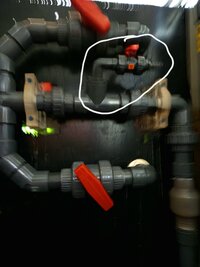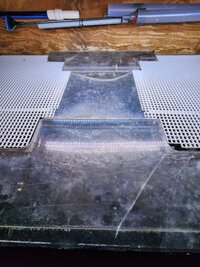2
22802
Guest
You had fantastic technology on your tank, and I learned a lot from that (not only CO2 wise).Yes I used a PLC and had a big pH drop 1.4pH and did the drop in 30mins. If the OP wasn't aiming for such a big pH drop I cant see why it would take to long if he used the same approach as I did ie twin injection for pH drop, single injection for keeping pH/CO2 stable. The main CO2 loss will be down to the surface area of top of tank. Will need very accurate/reliable timmers as slightest error could be fatal with twin injectors and twin solenoid valves - not for faint hearted with shallow pocket's
You will not be surprised I prefer to use the Horizontal Reactor, especially as it will be really hard to get a decent bubble reactor for 3800 litre, but I really like your double reactor with PLC approach (think you were probably the first with that).
I agree, and we all know that hobbyists have injected big tanks with bubble reactors and it worked. Aiming for 0.5 pH drop obviously will make things much easier compared to 1.5, 1000 litre will be much easier than 3800. With a partially closed system (top, or lid) easier than open top tanks with high surface agitation and outgassing.If the OP wasn't aiming for such a big pH drop I cant see why it would take to long if he used the same approach as I did ie twin injection for pH drop, single injection for keeping pH/CO2 stable
I have indeed advised @RickyV that he may want to go for a twin reactor approach, as you did, where one reactor helps only in the morning for a fast ramp up and will then be switched off by a timer. With the Horizontal Reactor feature of 'inherent safety', as I described earlier, we could then configure the capacity of second reactor, used for steady state operation during photoperiod, to never exceed a safe maximum CO2, even in the event of a technical failure.
I have not had time to do calculations, and probably nobody on UKAPS waits for 22802 to post another incomprehensible ramble with spreadsheets, but I suspect that some of the scary CO2 consumption numbers that were reported for big tanks were at least partially due to reactor inefficiencies (bubbles not dissolving), and not essentially due to the tanks minimum requirements.
@RickyV aims for 1.0 pH drop, has a closed top system and could close it more if needed with a lid, so I am pretty confident that CO2 consumption will not necessarily be outrageous. pH/Co2 controller is a must IMO, for such configuration on very big water volume, to achieve good stability during photoperiod, while allowing for less outgassing and thus CO2 savings.
EDIT: @RickyV has a sump with more than half the surface of the tank, so if both tank and sump would be not covered this would yield a pretty big outgassing area. For this worst case, and for a 1.5 pH drop (rather than 1.0 as @RickyV objective) I calculate that a 4 inch Horizontal Reactor over the full length will do. Just to have a feel how simple even such a huge tank with sump can be solved.
Last edited by a moderator:







